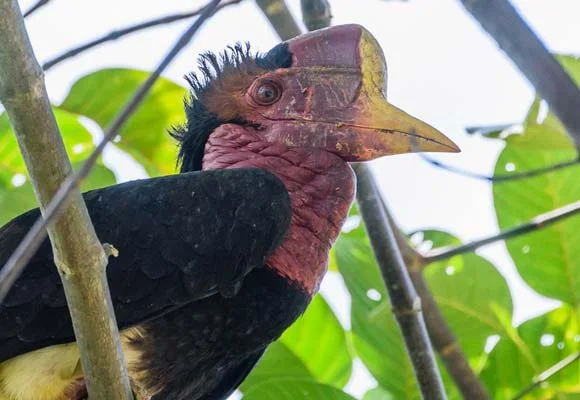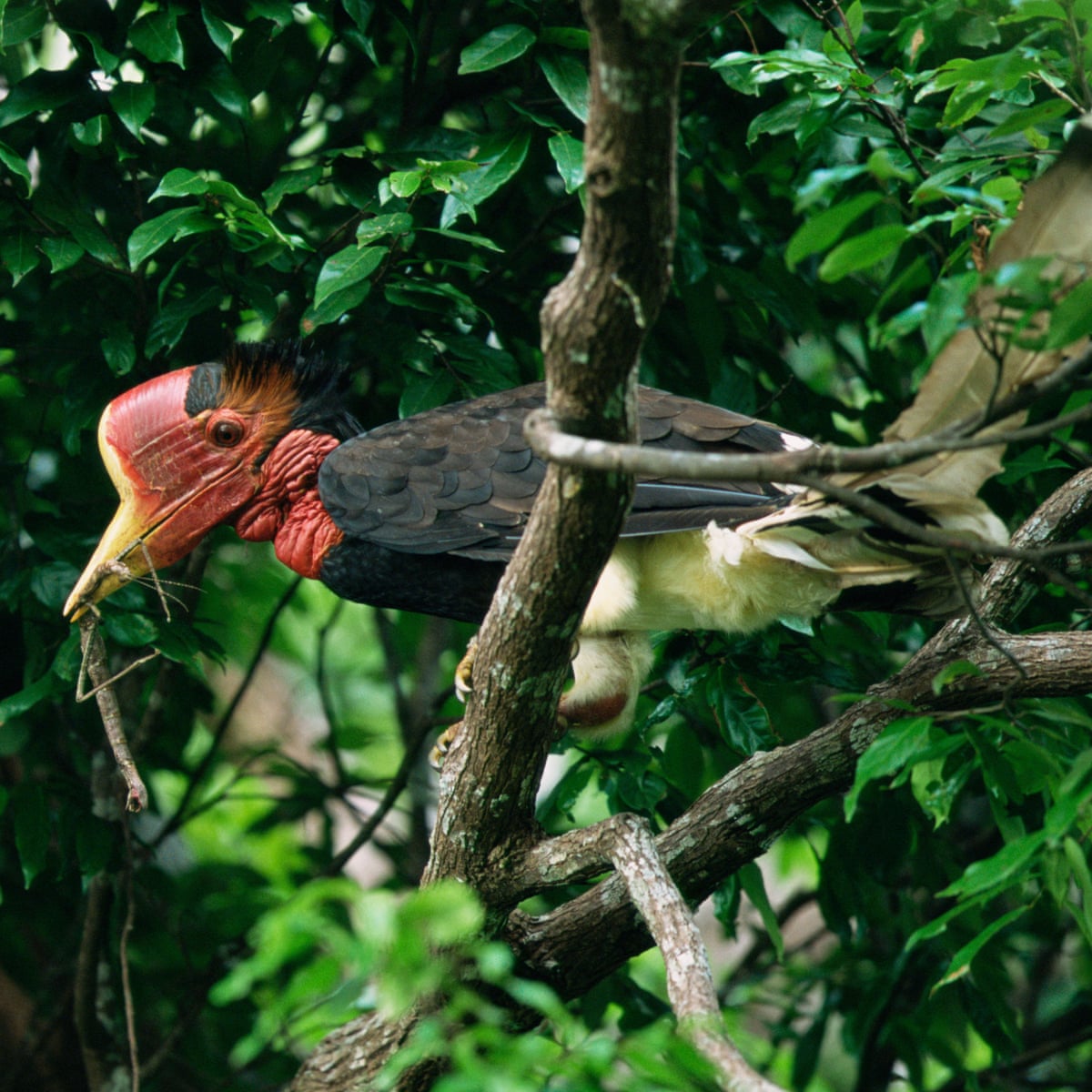
An Exceptional Avian
The helmeted hornbill is an exceptionally peculiar bird. It boasts a massive bill with a solid protrusion on the top, known as a casque, which is so enormous that it often gives the impression of baldness. Additionally, the bird features a sizable patch of featherless, leather-like skin on its neck that differs in colour between genders: blue in females and red in males.

The hornbill is a fascinating bird with some peculiar characteristics. Its call is quite unique, consisting of a loud series of hoots followed by a laughter-like sound that can be described as “maniacal”. In addition, the males of the species are known for their impressive aerial displays that sometimes result in loud collisions as their casques collide.
During the nesting period, the female hornbill seals herself inside a tree hole using a mixture of mud, clay, and sticky fruit to create a plaster-like substance. The seal is only left with a small opening, through which the male can feed his mate by regurgitating food. These are some interesting behaviors that make the hornbill stand out among other birds.

This captivating avian creature is facing a grave situation. It has been classified as critically endangered, largely because of illicit hunting for its distinctive casque. In the absence of stringent conservation measures, this species may soon become extinct.

The helmeted hornbill catches the eye and ear with its unique physical traits and behaviors. Its most striking feature is its solid casque, or helmet, which is made of the same keratin material as our nails. Unlike other birds with hollow casques, the helmeted hornbill’s is heavy and substantial. The bill and casque are brightly colored in red or yellow, while the skin on the neck is leathery and stands out from the bird’s feathers. Overall, this bird’s appearance is unlike any other and impossible to ignore.

The helmeted hornbill is mostly black, with white feathers on the belly, legs, and tail, which also has a black band. The feathers at the back of their eyes are brown tufts. Male helmeted hornbills weigh around 3.1 kg, while females weigh around 2.7 kg. Despite their size, they are not the heaviest hornbill in Asia; that title belongs to the great hornbill, which can weigh up to 4 kg.
Hornbills are a part of the Bucerotidae family and are generally tree-dwelling birds that fall into the subfamily Bucerotinae. However, ground hornbills have a distinct anatomical structure from the arboreal species and move by walking or running on the ground rather than hopping. Therefore, they belong to the Bucorvinae subfamily.

Did you know that there are other types of hornbills aside from Rhinoplax vigil? While all hornbills have big beaks, some also have casques. But it’s only the helmeted hornbill that has a solid casque. In contrast, the casques of its relatives have a spongy texture, and their beaks are typically curved downwards.

Researchers are still exploring the purposes served by the casque. Typically, males have a larger casque than females. Its development signifies sexual maturity. In some hornbill species, the casque serves as an amplifier for sound. For helmeted hornbills, the casque strengthens their beaks.

Hornbills are known for their unique physical characteristics that allow them to support their heavy beaks. Their first two neck vertebrae are fused together, and they have strong neck muscles. These features are believed to have evolved to help the birds handle the weight of their beaks.
When it comes to feeding, helmeted hornbills primarily eat fruit, particularly figs, making them important seed distributors in the forest. They also consume small animals such as mammals, reptiles, smaller birds, and insects. Thanks to their excellent vision, hornbills are adept at hunting for food, and it is suggested that they can even see the tip of their own beak – a remarkable skill for birds.
Hornbills use their powerful beaks to dig under tree bark to find insects. The weight of their casques enables them to use their beaks like hammers, while the tips of their beaks work like tweezers to pick up food. Given their short tongue, hornbills rely on a jerking motion to pass food picked up by the end of their beak to the back of their throat.

Birds have a penchant for hunting in the upper reaches of trees and tend to do so solo. Hornbills that live in trees often jump from branch to branch or even across the ground, coordinating their foot movements. Their flight is quite loud due to the rushing of air through their wings, particularly when they travel in packs.

The hornbill dedicates a portion of its day to grooming, ensuring that its feathers remain in optimal shape. A preen gland situated at the base of its tail produces an oily secretion that tints the bird’s yellow beak to a vibrant red hue. By using its beak, the hornbill distributes this substance evenly over its feathers.
